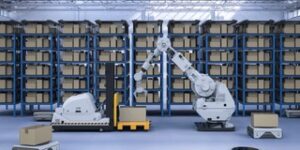 Welcome back. In the last piece, we looked at how warehouse robotics has evolved into a mainstream application subject, its benefits, and the various use cases. This time around, we shall look at the different types of robots out there classified basis applications. Let’s begin!
Welcome back. In the last piece, we looked at how warehouse robotics has evolved into a mainstream application subject, its benefits, and the various use cases. This time around, we shall look at the different types of robots out there classified basis applications. Let’s begin!
Over the years, robotics as an aspect of industrial science has evolved in leaps and bounds to be able to substitute many of the factory/warehouse floor activities that require human intervention. Today, activities like picking, segregating, packing and transportation are handled by robots in most technologically advanced companies.
Without further ado, let us dig into the different kinds of robots at work on the factory floor and how they are transforming the landscape of warehousing operations.
- Robotic arms
Robotic arms have been in use on the factory floor for decades now. Primarily, they have been employed in manufacturing and distribution segments. With the advent of time, there have been technological breakthroughs in the vision and gripper systems that facilitate smoother picking as well as pick-and-put operations.
These robots have amplified productivity at pick stations and put walls and stations dedicated to segregation activities. Besides, the use of these robotic arms has contributed to increased accuracy as well.
- Mobile racks goods-to-person robots
Mobile rack robots fetch inventory from racks and deliver it to the worker employed at another station. These come-to-me bots save precious energy, effort and time that would otherwise be expended in non-productive work like carrying a heavy part from one place on the factory floor to another. In different industry segments, these automatic robots are deployed to fetch garments or shelves from a storage space.
- Collaborative bots
These robots work in conjunction with the robots or employees stationed at the picking station. They have dramatically scaled down the time consumed in picking and transferring objects from one place to another. The meet-me category of robots falling under the label of collaborative robots wait at a picking area for workers to load them with goods. They then transfer the loaded products, effectively reducing the travel time for the worker.
The other kind of bots under this label ‘follow-me bots’ lead the worker to a picking location where products or goods are loaded onto them. Once a follow-me bot is fully loaded, it starts moving towards a designated area before another bot approaches the worker waiting to be loaded.
- Unit load transport autonomous mobile robots (AMR)
These robots are essentially deployed in areas where the movement of trucks or labourers is restricted or far too time and effort consuming. These AMRs provide flexibility and cost-efficiency.
of trucks or labourers is restricted or far too time and effort consuming. These AMRs provide flexibility and cost-efficiency.
They are deployed in the assembly line for products meant for transportation or transfer across long distances, that is, moving units from one section of the factory to the staging or receiving area. They are also used, in some cases, to transport trash and worn-out boxes, pallets as well as dunnage.
- Bot sorter AMRs
These bots have silently changed the dynamics of factory operations for e-commerce portals. Mainly put to use in sorting and segregating operations, these AMRs are capable of performing many-to-many segregation or consolidating products in one area, if so required.
In terms of logistics and supply-chain acceleration, these bots have delivered great results and amplified the cumulative productivity of any factory. One drawback, though, is that in cases of high throughput, these AMRs haven’t been as productive as, say, a traditional sorter.
- Roaming shuttle AMRs
These shuttles are used in a high-density storage or retrieval assembly line where storage or retrieval without additional time and energy consumption is key to nipping costs. The great advantage of these bots is that they open up the option for the company to scale up or scale down the storage space with little to no additional investment. Progressively, over the years, they have been gaining ground in domestic micro-fulfilment centres.
- Miscellaneous applications of robots
Truck loaders and worker-wearable exoskeletons are the new entrants on the scene, but they are far too expensive currently to be put into usage on a broad-based level. A bigger problem restricting the useful application of truck loaders is that they have comparatively lower throughput and can work smoothly only in relatively large staging areas. Other applications like automated robotic arms are still to be tested widely as far as their utility levels are concerned.
The final word
There is little doubt in the fact that the future of industrial production will be scripted and re-imagined by the robotics revolution. With the passage of time, many of these robots will become more cost-effective and will be accessible at economical prices, so much so that one day they will be utilised in smaller and micro-factories as well.
Stay tuned to our Knowledge Corner as we continue to bring you more interesting updates about from the world of Warehouse Robotics.


